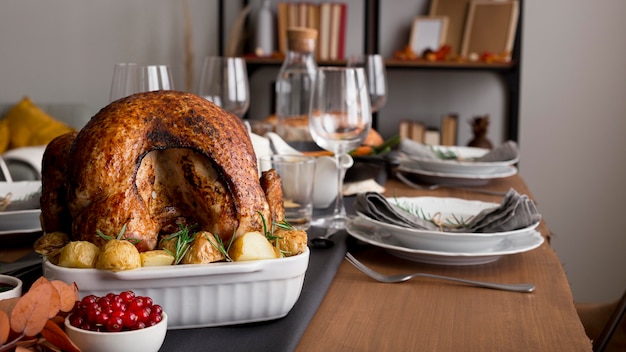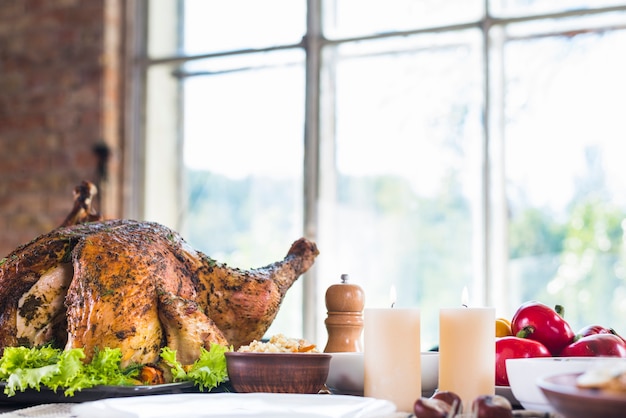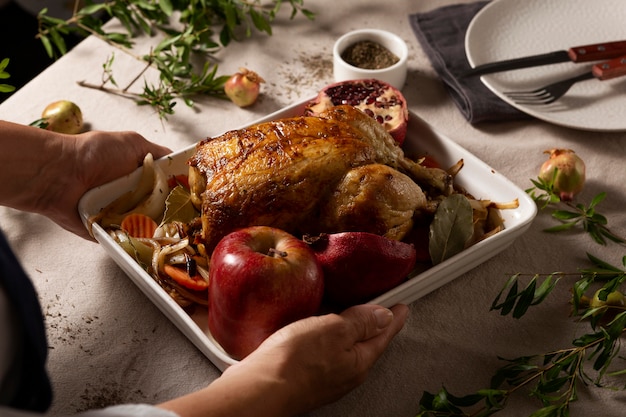Ah, the Christmas turkey. A majestic bird, a symbol of festive cheer, and, let's be honest, a bit of a culinary challenge, especially when you're dealing with a hefty 16lb specimen. But fear not, dear reader! I'm here to guide you through the whole process, from the initial thaw to the triumphant carving, sharing my own hard-earned wisdom and a few personal anecdotes along the way. After all, who better to guide you through this culinary adventure than someone who's been battling these giant birds for years?
(Part 1) The Great Thaw

First things first, let's talk turkey thawing. This is not a step to be taken lightly. You can't simply yank that frozen bird out of the freezer and toss it straight into the oven – that's a recipe for a disastrously uneven and possibly unsafe dinner. The key here is patience and a bit of foresight.
Thawing Strategies: Choosing the Right Method
There are a few ways to thaw your turkey, each with its own advantages and drawbacks. Let's explore them:
- The Refrigerator Method: This is the classic, tried-and-true method. You know, the one Grandma always used. It's slow and steady, but oh-so-reliable. A 16lb turkey will take about 3-4 days in the refrigerator to thaw completely. Just remember to place it on a tray to catch any drips. I've learned the hard way that a puddle of turkey juice on your fridge shelf isn't a pleasant surprise!
- The Cold water bath: Now, this is for the impatient amongst us. I confess, I'm a bit of a fan of this method when time is tight. It involves submerging the turkey in a large bowl of cold water, making sure it's fully covered. The trick is to change the water every 30 minutes or so to keep it nice and cold. A 16lb turkey will usually thaw in this way within 3-4 hours. Be warned, though: this method requires constant vigilance. One forgotten water change and you're back to square one!
- The Never-Do Method: Thawing a turkey at room temperature? Absolutely not! This is a big no-no. Bacteria love warm environments and can multiply rapidly at room temperature, making your turkey unsafe to eat. Trust me, you don't want to risk a trip to the emergency room!
(Part 2) The Brining Business: A Question of Moisture and Flavor

Ah, brining. This is where opinions diverge, like a flock of geese migrating south. Some swear by it, some scoff at it. I, personally, am a firm believer in brining, especially for a large turkey. It's like giving your bird a spa treatment before the big day, leaving it juicy, tender, and bursting with flavor. It's a real game changer, and well worth the extra effort.
Brining Basics: Mastering the Art of the Salty Soak
A basic brine is made with salt, sugar, and water. You can get fancy and add herbs, spices, or citrus fruits, but I prefer to keep it simple. A classic rosemary and thyme brine always adds a lovely festive touch. Remember, your brine should be cold, and you'll need a container big enough to comfortably hold your turkey.
Brining Time: The Longer, the Better (Within Reason)
For a 16lb turkey, I recommend a brining time of 12-24 hours. The longer you brine, the juicier and more flavorful your turkey will be. Just be sure to factor that extra time into your festive planning. You don't want to be scrambling to get everything done on Christmas Eve, with a turkey still soaking in the fridge!
(Part 3) Prep Time: Putting the Finishing Touches on Your Turkey

Once your turkey is thawed (and brined, if that's your style), it's time to get hands-on. This is where you add those finishing touches that will make your turkey truly shine.
Stuffing Shenanigans: A Matter of Preference and Safety
Stuffing is one of those culinary topics that sparks heated debate. Some people adore it, others are indifferent, and some even consider it a culinary abomination. Personally, I'm a big fan of stuffing, but I always cook it separately. No stuffing inside the bird for me! That's because stuffing needs to be cooked to an internal temperature of 165°F (74°C), just like the turkey. Stuffing inside the bird can sometimes be undercooked, creating a potential food safety hazard. Cooking it separately ensures it's safe and delicious.
Patting and Plumping: Getting That crispy skin
Now, with your stuffing cooked (or discarded), pat your turkey dry with paper towels. This is crucial for achieving that crispy, golden-brown skin that everyone loves. Then, you can give your turkey a little love with some butter or olive oil, or go for a dry rub for extra flavour. I'm partial to a simple mix of paprika, garlic powder, and onion powder, which always adds a classic touch.
(Part 4) Roasting Revelation: Time to Let the Magic Happen
This is it, the grand finale! You've prepped your turkey, it's all set, and now it's time to let the roasting magic begin!
Oven Temperature: Finding the Goldilocks Zone
For a 16lb turkey, I always aim for a roasting temperature of 350°F (175°C). This ensures even cooking without drying out the bird. Resist the urge to crank up the heat. It might seem like a good idea, but it can lead to uneven cooking and a burnt exterior. Remember, we want a beautiful, juicy turkey, not a charcoal-grilled disaster!
roasting time: A Rough Guide, Not a Precise Science
This is where things get a little tricky. Every oven is different, and every turkey has its own unique personality. But a good rule of thumb is to allow 15-20 minutes per pound of turkey. So, a 16lb turkey will take approximately 4 hours to cook. This is just a guide, though. It's best to be prepared for a bit of flexibility.
turkey thermometer: The Unsung Hero of the Roast
To avoid undercooked turkey, which is a big no-no in the world of festive feasts, use a meat thermometer! It's your best friend in this process. Stick it into the thickest part of the thigh, and make sure it registers 165°F (74°C). Don't rely solely on visual cues. The turkey might look cooked before it actually is. The thermometer tells the real story!
Resting Ritual: A Moment of Patience for the Perfect Feast
Once your turkey is cooked, don't jump right into carving. Give it a 30-minute rest, at least. This allows the juices to redistribute throughout the meat, making for a more tender and flavorful turkey. Cover the turkey loosely with foil to keep it warm while it rests. This is a crucial step, so don't skip it!
(Part 5) Carving Chronicles: The Art of the Slice
The moment has finally arrived! The turkey is rested, the juices are flowing, and you're ready to carve. This is a crucial step, so take your time, be patient, and follow these tips to avoid a culinary disaster.
Carving Tools: The Essential Equipment for a Successful Carve
You'll need a sharp carving knife and a carving fork. Make sure that knife is razor-sharp, capable of slicing through the meat cleanly. If you're struggling, a good carving fork will help you to hold the turkey steady while you carve.
Carving Technique: A Step-by-Step Guide
Start by removing the legs and thighs. Then, carve the breast meat in thin slices, being careful not to tear the meat. Aim for even slices, and don't be afraid to ask for help if you need it.
Presentation Perfection: Making a Feast for the Eyes
Once your turkey is carved, arrange the slices attractively on a platter. You can garnish it with herbs, citrus fruits, or roasted vegetables. Remember, presentation matters! It's the first thing your guests will see, so make it look as delicious as it tastes.
(Part 6) Gravy Goodness: The Essential Complement to a roast turkey
No roast turkey is truly complete without a generous helping of gravy. It's the perfect complement to the succulent turkey meat, adding a rich, savory flavour to the entire dish.
Gravy Making: From Scratch or Store-Bought?
You can make gravy from scratch using turkey drippings, or you can use a store-bought gravy base. I prefer to make my own gravy, as it's easy to customize with herbs and spices to suit my taste. Simply whisk together the drippings with flour and stock, and bring to a simmer.
Gravy Tips: Ensuring a Smooth, Delicious Sauce
Make sure your gravy is smooth and lump-free. You can use a whisk or a blender to ensure a silky texture. Season the gravy to taste, and feel free to add a splash of wine or lemon juice for extra flavour.
(Part 7) turkey leftovers: Turning Leftovers into Culinary Treasures
You've conquered the roast turkey, the feast is over, and you're left with a mountain of leftovers. But don't despair, dear reader! These leftovers are an opportunity to create new and delicious dishes.
Leftover Wonders: Transforming Turkey into New Delights
Here are a few ideas for turkey leftovers, transforming them from a simple leftover into culinary treasures:
- turkey sandwiches: A classic for a reason! You can use the leftover turkey in a variety of sandwiches, from simple turkey on bread to more elaborate creations with cranberry sauce, stuffing, and cheese.
- turkey salad: Chop up the leftover turkey and combine it with mayonnaise, celery, onion, and cranberries for a delicious and refreshing salad.
- turkey soup: A hearty and comforting soup. You can use the leftover turkey, bones, and vegetables to make a rich and flavorful soup.
- turkey pot pie: Combine the leftover turkey with vegetables, gravy, and a flaky crust for a satisfying pot pie.
- Turkey Casserole: A versatile and budget-friendly meal. You can use the leftover turkey with potatoes, gravy, and cheese to create a delicious and comforting casserole.
(Part 8) A Final Word: Embrace the Festive Feast
There you have it, a comprehensive guide to roasting a 16lb turkey. It's a journey, a culinary adventure, and yes, it's a lot of work. But the result is truly worth the effort. This isn't just a meal, it's a tradition, a gathering point, a symbol of the festive season. So, go forth, armed with this knowledge, and let your turkey be the star of the show!
FAQs
| Question | Answer |
|---|---|
| How long does it take to cook a 16lb turkey? | It's hard to give an exact time, as every oven and turkey is different, but a good rule of thumb is 15-20 minutes per pound. So, a 16lb turkey will take around 4 hours to cook. However, it's always best to use a meat thermometer to ensure it's cooked through. |
| What's the best way to check if the turkey is cooked? | Use a meat thermometer! Stick it into the thickest part of the thigh, and it should register 165°F (74°C) for the turkey to be cooked through. This is the most reliable way to ensure food safety. |
| Can I stuff the turkey before roasting? | It's safer to cook stuffing separately. This ensures it's cooked to the proper internal temperature of 165°F (74°C) and avoids potential food safety issues. |
| What's the best way to store leftover turkey? | Refrigerate the turkey in airtight containers within 2 hours of cooking. It should last for up to 4 days in the fridge. You can also freeze leftover turkey for up to 2 months. |
| What are some good gravy recipes for turkey? | You can make gravy from scratch using turkey drippings, or use a store-bought gravy base. Get creative and add your own herbs and spices for a unique flavour. For a classic flavour, try a simple mix of thyme, rosemary, and a touch of garlic. |
Everyone is watching

Corn on the Cob: The Ultimate Guide to Perfectly Cooked Ears
Healthy MealsAh, corn on the cob. Just the name evokes images of sunny days, barbecues, and that sweet, juicy flavour that ...

Perfect Pork Roast Oven Cooking Time: A Guide to Delicious Results
Healthy MealsThere's something truly satisfying about a perfectly roasted pork. The aroma alone is enough to make your mout...

Ham Cooking Time: How Long to Bake, Smoke, or Boil a Delicious Ham
Healthy MealsAh, ham. It's a classic, isn't it? A real crowd-pleaser, especially around holidays. And when done right, it'...

Scallops: The Ultimate Guide to Perfect Cooking
Healthy MealsAh, scallops. Those delicate, sweet, and utterly delicious morsels of the sea. They hold a special place in my...

Spaghetti Squash: The Ultimate Guide to Cooking and Serving
Healthy MealsRemember that time you saw spaghetti squash at the supermarket, looking all bumpy and strange, and thought, "W...
